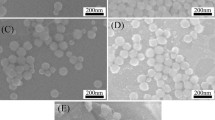Abstract
Abrasive properties of cocoon shaped silica particles fabricated by a sol–gel method have been studied. Since silicon wafers are polished with slurry by the mechanism of Chemical Mechanical Polishing, polishing rates may depend on various chemical and mechanical factors, such as particle concentration in slurry, slurry pH and kinds of basic compounds for controlling the slurry pH.
The silicon wafer was polished by slurry continuously fed on a pad, and the polishing rate was estimated as a weight loss of the wafer. For studying the effects of the various factors on the rate, the slurries were prepared by adding the silica particles, basic compounds or salts, and the polishing rates of the slurry were measured.
The effects of the various factors were made clear as follows: For the effect of particle concentration, the rates increased with increasing of the concentrations up to 1.0 wt.%. And for the effect of the slurry pH, slurries added basic compounds, such as KOH, NaOH, ammonia, were tested, and it was found that increasing of the slurry pH brought increases of the polishing rates. KOH-containing slurry of pH 13.2 had the fastest rate, 3.6 times as fast as the standard slurry with pH 9.4. For the effect of the adding of salts, it was indicated that the salts, such as KCl, NaCl, NH4Cl, NaNO3 and K2SO4 increased the polishing rates, and that KCl-containing slurry of 0.36 mol/l had the highest polishing rate, 3.4 times as fast as that of the standard slurry containing no salts.








Similar content being viewed by others
References
Stöber W, Fink A, Bohn E (1968) J Colloid Interf Sci 26:62
Arai Y, Segawa H, Yoshida K (2004) J Sol–Gel Sci Technol 32:79
Chuhong Zhou, Lei Shan, Hight JR, Danyluk S, Ng SH, Paszkowski AW (2002) J Soc Tribol Lubr Eng, August 2002:35
Brown NJ, Baker PC, Maney RT (1981) Proc SPIE 306:42
Cook LM (1990) J Non-Cryst Solids 120:152
Jairath R, Desai M, Stell M, Tolles R, Scherber-Brewer D (1994) Mat Res Soc Symp Proc 337:121
Mahajan U, Bielmann M, Singh RK (1999) Mat Res Soc Symp Proc: -Chemical-Mechanical Polishing- Fundamentals and Challenges 566:27
Izumitani T (1984) Tech. Digest, Topical Meeting on the Science of Polishing, Paper TuB-A1, Optical Society of America
Alexander GB, Heston WM, Iler RK (1954) J Phys Chem 58:453
Iler RK (1979) The chemistry of silica. J. Willey and sons, New York
Mahajan U, Bielmann M, Singh RK (1999) Electrochem Solid-State Lett 2:80
Acknowledgement
The author thanks Mr. Toshio Nozaki and Dr. Masayuki Yamane of Tytem Corporation for their help and invaluable cooperation.
Author information
Authors and Affiliations
Corresponding author
Rights and permissions
About this article
Cite this article
Yoshida, K. Abrasive properties of nano silica particles prepared by a sol–gel method for polishing silicon wafers. J Sol-Gel Sci Technol 43, 9–13 (2007). https://doi.org/10.1007/s10971-007-1567-1
Received:
Accepted:
Published:
Issue Date:
DOI: https://doi.org/10.1007/s10971-007-1567-1



